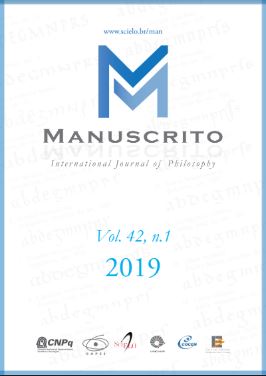Resumen
In the literature,Weak Kleene logics are usually taken as three-valued logics. However, Suszko has challenged the main idea of many-valued logic claiming that every logic can be presented in a two-valued fashion. In this paper, we provide two-valued semantics for the Weak Kleene logics and for a number of four-valued subsystems of them. We do the same for the so-called Logics of Nonsense, which are extensions of the Weak Kleene logics with unary operators that allow looking at them as Logics of Formal Inconsistency (LFIs) and Logics of Formal Underterminedness (LFUs). Our aim with this work, rather than arguing for Suszko’s thesis, is to show that two-valued presentations of these peculiar logics enlighten the non-standard behavior of their logical connectives. More specifically, the twovalued presentations of paraconsistent logics illustrate and clarify the disjunctive flavor of the conjunction, and dually, the two-valued presentations of paracomplete subsystems of Weak Kleene logics reveal the conjunctive flavor of the disjunction.
Citas
[2] J. Beall and D. Ripley. Analetheism and dialetheism. Analysis, 64(281):30–35, 2004.
[3] D. A. Bochvar. On a three-valued logical calculus and its application to the analysis of the paradoxes of the classical extended functional calculus. History and Philosophy of Logic, 2(1-2):87– 112, 1981. Translated by M. Bergmann.
[4] S. Bonzio, J. Gil-Férez, F. Paoli, and L. Peruzzi. On paraconsistent weak kleene logic: Axiomatisation and algebraic analysis. Studia Logica, pages 1–45, 2016.
[5] C. Caleiro, W. Carnielli, M. E. Coniglio, and J. Marcos. Two’s company: “The humbug of many logical values”. In J.-Y. Beziau, editor, Logica Universalis, pages 169–189. Birkhäuser, Basel, 2005.
[6] W. Carnielli and M. Coniglio. Paraconsistent Logic: Consistency, Contradiction and Negation. Springer, 2016.
[7] W. Carnielli, M. Coniglio, and J. Marcos. Logics of Formal Inconsistency. In D. Gabbay and F. Guenthner, editors, Handbook of Philosophical Logic, volume 14, pages 1–93. Springer, Dodrecht, 2007.
[8] W. Carnielli, J. Marcos, and S. De Amo. Formal inconsistency and evolutionary databases. Logic and Logical Philosophy, 8:115–152, 2004.
[9] R. Ciuni. Conjunction in Paraconsistent Weak Kleene Logic. In P. Arazim and M. Dancák, editors, The Logica Yearbook 2014, pages 61–76. College Publications, London, 2015.
[10] R. Ciuni and M. Carrara. Characterizing Logical Consequence in Paraconsistent Weak Kleene. In L. Felline, A. Ledda, F. Paoli, and E. Rossanese, editors, New Directions in Logic and the Philosophy of Science, pages 165–176. College Publications, London, 2016.
[11] M. I. Corbalán. Conectivos de Restauração Local. Master’s thesis, Universidade Estadual de Campinas, Instituto de Filosofia e Ciências Humanas, 2012.
[12] N. da Costa and E. Alves. A semantical analysis of the calculi Cn. Notre Dame Journal of Formal Logic, 18(4):621–630, 1977.
[13] N. da Costa and A. Arruda. Une sémantique pour le calcul C1. Comptes Rendus de l’Académie des Sciences de Paris, 284:279–282, 1976.
[14] B. Da Ré, F. Pailos, and D. Szmuc. Theories of truth based on four-valued infectious logics. Logic Journal of the IGPL, 2017. Forthcoming.
[15] H. Deutsch. Paraconsistent analytic implication. Journal of Philosophical Logic, 13(1):1–11, 1984.
[16] T. M. Ferguson. Faulty Belnap computers and subsystems of FDE. Journal of Logic and Computation, 2014.
[17] M. Fitting. Bilattices are nice things. In T. Bolander, V. Hendricks, and S. A. Pedersen, editors, Self-Reference, pages 53–78. CSLI Publications, 2006.
[18] S. Frankowski. Formalization of a plausible inference. Bulletin of the Section of Logic, 33(1):41– 52, 2004.
[19] S. Halldén. The logic of nonsense. Uppsala Universitets Årsskrift, Uppsala, 1949.
[20] L. Humberstone. Power Matrices and Dunn– Belnap Semantics: Reflections on a Remark of Graham Priest. Australasian Journal of Logic, 11(1):14–45, 2014.
[21] S. C. Kleene. Introduction to metamathematics. North-Holland, Amsterdam, 1952.
[22] J. Łukasiewicz. On three-valued logic. Ruch Filozoficzny, 5, 1920. English translation in Borkowski, L. (ed.) Jan Lukasiewicz: Selected Works, Amsterdam: North Holland, 1970.
[23] G. Malinowski. Q-consequence operation. Reports on Mathematical Logic, 24(1):49–59, 1990.
[24] G. Malinowski. Inferential many-valuedness. In J.Wolenski, editor, Philosophical Logic in Poland, pages 75–84. Kluwer Academic Publishers, 1994.
[25] J. Marcos. Nearly every normal modal logic is paranormal. Logique et Analyse, 48(189-192):279– 300, 2005.
[26] C. A. Oller. Paraconsistency and analyticity. Logic and Logical Philosophy, 7:91–99, 1999.
[27] H. Omori and D. Szmuc. Conjunction and disjunction in infectious logics. In A. Baltag, J. Seligman, and T. Yamada, editors, Logic, Rationality, and Interaction: 6th International Workshop (LORI 2017), pages 268–283, Berlin, 2017. Springer.
[28] W. T. Parry. Ein axiomensystem für eine neue art von implikation (analytische implikation). Ergebnisse eines mathematischen Kolloquiums, 4:5–6, 1933.
[29] G. Priest. Plurivalent logics. The Australasian Journal of Logic, 11(1):2–13, 2014.
[30] L. Rosenblatt. Two-valued logics for transparent truth theory. Australasian Journal of Logic, 12:44–66, 2015.
[31] K. Segerberg. A contribution to nonsenselogics. Theoria, 31(3):199–217, 1965.
[32] Y. Shramko and H. Wansing. Truth and falsehood: An inquiry into generalized logical values. Springer, 2011.
[33] R. Suszko. Remarks on Łukasiewicz’s threevalued logic. Bulletin of the Section of Logic, 4(3):87–90, 1975.
[34] R. Suszko. The Fregean Axiom and Polish Mathematical Logic in the 1920s. Studia Logica, 36(4):376–380, 1977.
[35] D. Szmuc. Defining LFIs and LFUs in extensions of infectious logics. Journal of Applied Non- Classical Logics, 26(4):286–314, 2016.
[36] D. Szmuc and H. Omori. A Note on Goddard and Routley’s Significance Logic. Australasian Journal of Logic, 15(2):431–448, 2018.
[37] M. Tsuji. Many-valued logics and Suszko’s thesis revisited. Studia Logica, 60(2):299–309, 1998. Manuscrito – Rev. Int. Fil. Campinas, v. 42, n. 1, pp. 1-43, Jan-Mar. 2019.


